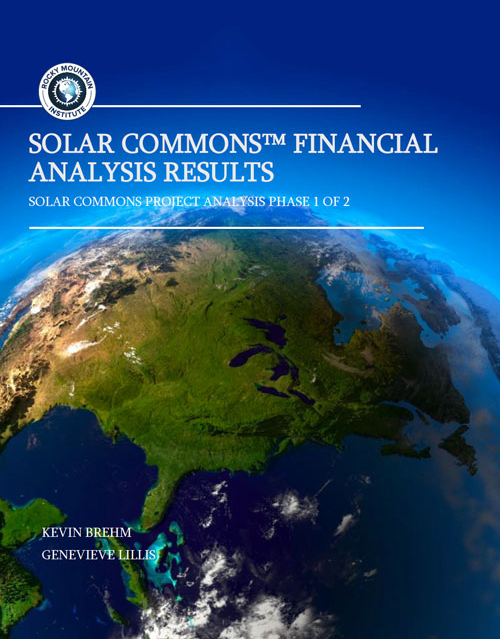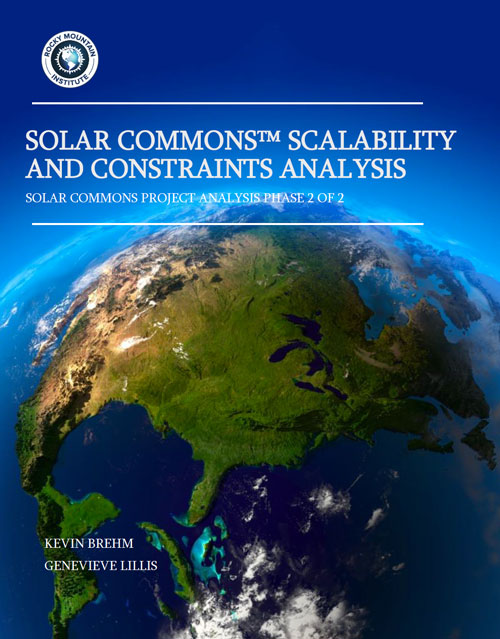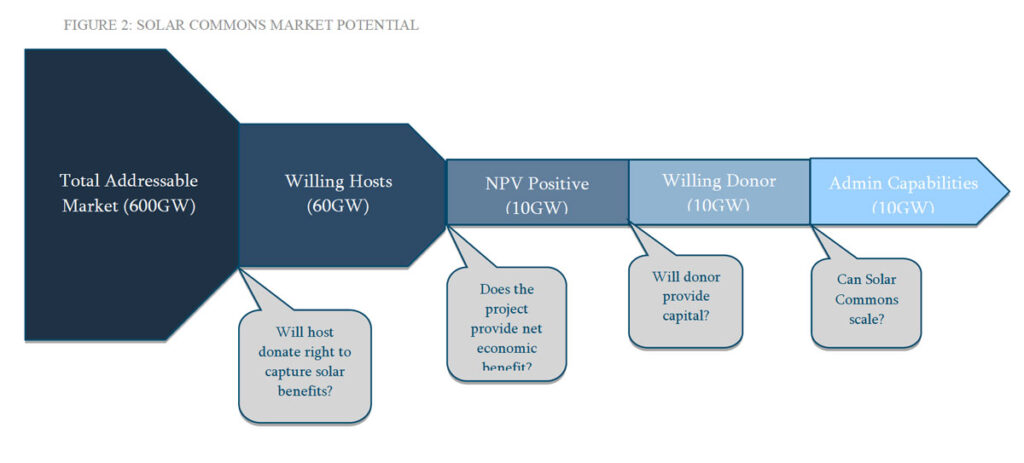
Overview
The most important factor in stopping climate change is mitigating the release of carbon dioxide and other greenhouse gases into our atmosphere. The Solar Commons Project reduces CO2 and embeds the value of the earth’s climate system in the common wealth values of healthy and equitable local livelihoods. The Rocky Mountain Institute (RMI), the nation’s premier research institute on accelerating and scaling the shift from fossil fuels to efficiency and renewable energy, has analyzed the Solar Commons Model. Read the RMI reports below showing how funders realize quantifiable GHG reductions and a positive net present value on the money they put into a Solar Commons array. Also read the RMI scalability study showing how rightly-sized, distributed Solar Commons iterate to a minimum of 10GW in the US!
Climate Mitigation Embedded in Social Systems
The Solar Commons Project mitigates climate change in ways that demonstrate both quantitative and qualitative impacts embedded in social systems. In quantitative ways, direct GHG reductions are measurable with each Solar Commons array built. The Solar Commons Project increases the capacity for Solar Commons arrays to be built by building the civic tools—legal templates and digital dashboards for local, transparent governance and reporting of the Solar Commons Trusts— that increase administrative capacity and local—rural and urban—appreciation of the common wealth benefits of solar energy. Solar Commons arrays can also be built with batteries to provide communities with the adaptive resilience needed for power grid failures. Qualitatively, the Solar Commons Project increases awareness of the value of solar energy beyond GHG reductions and energy resilience. By embedding solar energy in a “moral economy” that distributes economic value for long term support to local low-income community empowerment projects, donors and the general public learn how the market economy that determines energy pricing can be embedded in a moral framework where the flourishing of nature and equity of communities is valued and organized as common wealth. These quantitative and qualitative impacts of Solar Commons support the Iteration Plan for Solar Commons throughout the United States.
Quantitative Impacts of the Solar Commons Project
The Rocky Mountain Institute (RMI), the nation’s premier research institute on accelerating and scaling the shift from fossil fuels to efficiency and renewable energy, has provided a quantitative analysis of both the financial model and the scaling capacity of the Solar Commons Project.

Summary of RMI’s Solar Commons Model Financial Analysis (page 3)
- RMI analyzed the financial and environmental benefits of Solar Commons projects in three states (Arizona, Colorado, and Minnesota), for three system sizes (14.5 kW, 410 kW, and 500 kWi) and under two rate options (community solar and behind-the-meter)
- Solar Commons provides significant benefits to the environment and to community beneficiaries (the trust) under all scenarios.
- Solar Commons further provides a positive net present value (NPV) to an impact-focused donor for all system sizes in Arizona.
- Solar Commons provides a positive NPV for community solar projects in Colorado and Minnesota, and for large behind-the-meter systems in Colorado.
- Financial performance of behind-the-meter Solar Commons projects are highly dependent on rate structure, location-specific solar production, and the impact of solar on a system host’s monthly peak demand.

Summary of RMI’s Solar Commons Scalability Analysis (pages 3 & 4)
Solar Commons is a broadly scalable model, that could be applied to most behind-the-meter or community solar project in the US. This report starts by defining the total addressable market for the Solar Commons model then defines constraints that may limit Solar Commons growth. It finds that:
- The total addressable market for Solar Commons is 600 GW or more
- Availability of willing hosts and access to positive economics are most likely to constrain the potential market for Solar Commons
- Even considering binding market constraints, the total market potential for Solar Commons could be 10 GW or more
Total Addressable Market
The Solar Commons model can be expanded to any location where the following actors can undertake the following actions:
- A donor can give money to pay for a project.
- A host/ co-trustee can donate the right to directly capture solar bill credits.
- A vendor (or qualified co-trustee) can build and maintains a project.
- A utility will provide some credit (net metering or otherwise) to a solar project.
- A trust can manage a project and distribute benefits.
- A beneficiary can capture benefits.
The Solar Commons model is broadly applicable and is not dependent on any specific policies (e.g., community solar legislation). Since hosts in the Solar Commons model are generally commercial or industrial energy users, the total addressable market for the Solar Commons model will be linked to the potential market for commercial and industrial (C&I) solar.
By targeting commercial customers, Solar Commons has the potential to install larger scale solar projects compared with existing philanthropic models that tend to target residential customers. In 2016, NREL found the total Technical Potential for distributed commercial PV to be 600GW. This technical potential considers system and topographic constraints, land-use constraints and system performance. According to NREL’s Report, the Economic Potential for midscale Commercial and Industrial solar was greater than 100 GW. The economic potential further considers projected technology costs, as well as available verse required revenue for renewable energy projects.
This report will consider the distributed commercial technical potential (600 GW) to be the total addressable market for Solar Commons projects. Solar Commons potential market will be analyzed based on constraints on the total addressable market.

In addition to the quantitative benefits on GHG deductions noted by the RMI studies above, Solar Commons arrays offer climate adaptation benefits by including battery storage and microgrid function that provides community resilience against electricity disruption on transmission and distribution grids. Battery storage on Solar Commons arrays also allows more energy savings to be passed on to the Solar Commons Trust Fund by selling solar generated electricity back into the grid at higher demand time prices. There are multiple, quantitatively measurable benefits to Solar Commons arrays.
Qualitative Impacts of the Solar Commons Project
The Solar Commons Project also provides qualitative benefits on climate change mitigation through its educational tools and public art. Public art for Solar Commons is visible on the digital dashboard used by donors, hosts, trustees and beneficiaries to transparently measure the sun’s radiance and the array’s electricity production, and to govern, account for and report on the revenue stream that goes into the social wealth fund and out to the community empowerment projects. Solar Commons public art is also visible in murals and other place-making art activities in neighborhoods where Solar Commons beneficiaries reside. On both dashboards and community sites, Solar Commons are educating the public on how the transition to renewable energy will reduce C02 and other green house gases and mitigate climate change. Importantly, the quantitative measures showing GHG reduction are embedded in qualitative understandings of the value of renewable energy for building healthy and equitable neighborhoods and environments.


